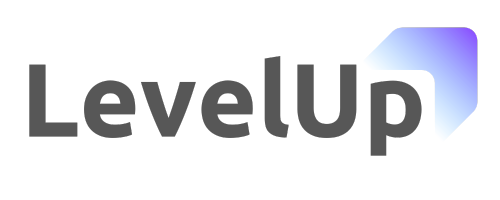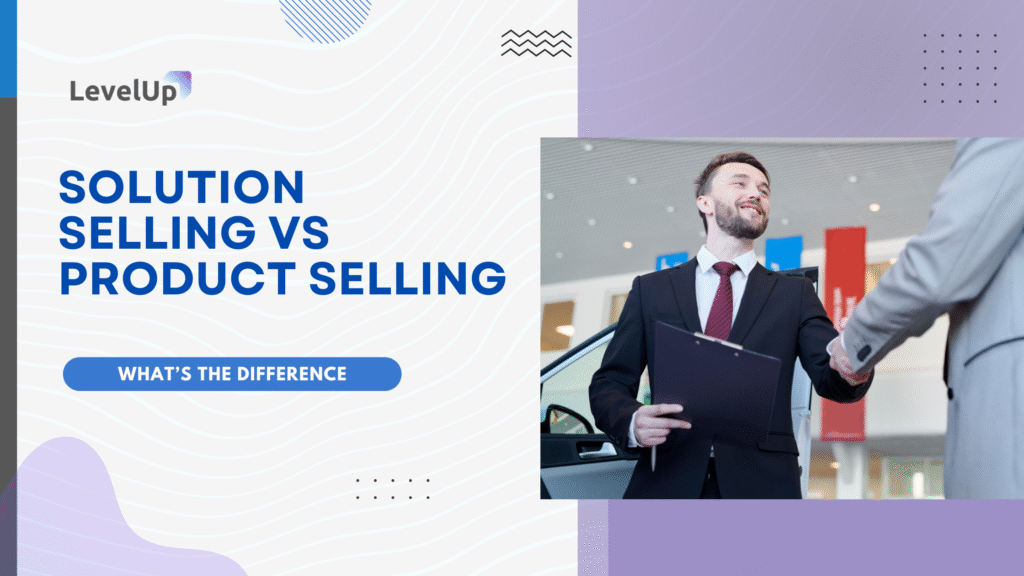Picture this: I’m sitting in a coffee shop last Tuesday, overhearing a conversation between two startup founders at the next table. One was practically shouting about his product’s “revolutionary 47 features” while the other was shaking her head, saying something about “solving real problems first.”
It hit me—they were having the classic solution selling vs product selling debate without even realizing it.
Here’s the thing: the difference between solution selling and product selling isn’t just sales jargon. It’s the difference between building a sustainable business and constantly chasing your next customer. Solution selling focuses on understanding and solving customer problems, while product selling emphasizes features and immediate transactions.
If you’re wondering “what is solution selling vs product selling?” and which approach will actually move the needle for your business, you’re in the right place. I’ve spent the last eight years helping SaaS companies figure this out, and honestly? Most founders get it backwards.
Let me walk you through everything I’ve learned about these two approaches—including the mistakes I made early on that cost me deals I should’ve won.
What Is Solution Selling? (And Why It Actually Works)
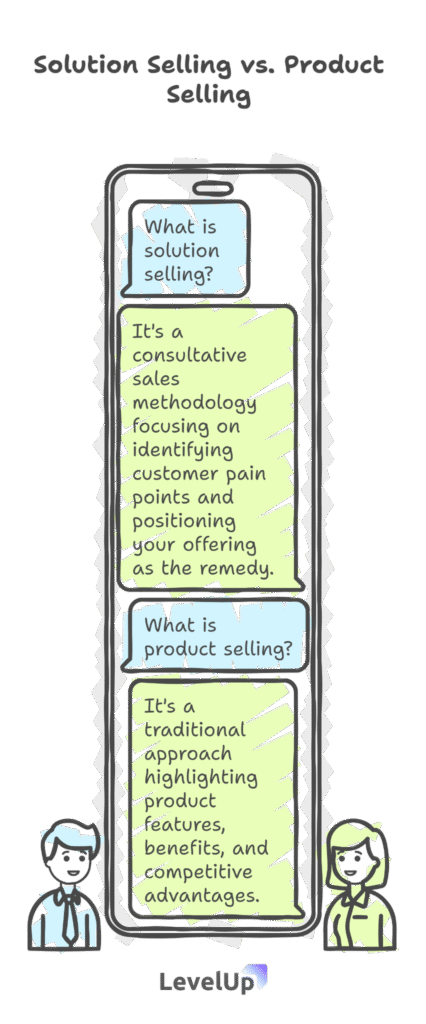
Solution selling is like being a business detective. Instead of walking into a meeting with a pre-planned pitch about your product’s bells and whistles, you’re asking questions. Lots of them.
Solution selling is a consultative sales methodology where you focus on identifying specific customer pain points and positioning your offering as the remedy to their problems. It’s about becoming a trusted advisor rather than just another vendor.
I remember working with a client who sold project management software. Their original pitch was all about “advanced Gantt charts” and “robust reporting capabilities.” Yawn, right?
After we shifted to solution selling, their reps started asking questions like: “What happens when your projects run over deadline?” and “How do you currently track team productivity?”
The difference? Night and day.
Key Characteristics of Solution Selling:
Customer-Centric Discovery: You spend significant time understanding the prospect’s business, challenges, and goals before presenting anything.
Consultative Approach: You position yourself as an advisor who happens to have a solution, not a salesperson pushing a product.
Problem-First Mentality: The conversation starts with pain points, not product features.
Long-term Relationship Focus: You’re building trust for ongoing partnerships, not just closing one-time deals.
Customized Presentations: Every pitch is tailored to the specific problems you’ve uncovered.
Here’s what surprised me most about solution selling: it actually makes the sales process easier. When you truly understand someone’s problems, presenting your solution feels natural—not pushy.
What Is Product Selling? (The Traditional Approach)
Product selling is what most of us default to. It’s the “spray and pray” method where you highlight your product’s features, benefits, and competitive advantages, hoping something sticks.
Product selling focuses on the product itself—its specifications, pricing, and how it compares to competitors. It’s more transactional and often follows a standardized sales script.
Don’t get me wrong—product selling isn’t inherently bad. I’ve seen it work brilliantly for commodity products or when you’re dealing with buyers who already know exactly what they need.
But here’s the catch: in today’s market, especially in B2B and SaaS, buyers are drowning in options. They don’t need another feature list. They need someone who understands their world.
Key Characteristics of Product Selling:
Feature-Focused: Conversations revolve around what your product does and how it works.
Standardized Pitches: You use similar presentations for most prospects.
Quick Transaction Focus: The goal is to close deals fast.
Competitive Positioning: Heavy emphasis on how you’re better than alternatives.
Price-Driven Negotiations: Discussions often center on cost and immediate ROI.
I’ll be honest—I used product selling for the first three years of my consulting business. My presentations were polished, my feature comparisons were thorough, and my close rate was… mediocre at best.
The Real Difference: Solution Selling vs Product Selling in Practice
The fundamental difference comes down to this: solution selling starts with the customer’s problems, while product selling starts with your product’s capabilities.
Let me give you a real example that illustrates this perfectly.
A Tale of Two Sales Calls
Product Selling Approach:
“Hi Sarah, thanks for your interest in our CRM. Let me show you our advanced lead scoring algorithm, our automated email sequences, and our robust analytics dashboard. We integrate with 200+ tools and offer 24/7 support. Our Enterprise plan is 30% cheaper than Salesforce.”
Solution Selling Approach:
“Hi Sarah, I noticed on your demo request that you mentioned struggling with lead follow-up. Can you tell me more about what’s happening there? What’s your current process when a lead comes in?”
See the difference? The first approach assumes Sarah cares about lead scoring algorithms. The second approach tries to understand Sarah’s actual experience.
Why This Matters for Your Business
According to recent research, companies using consultative selling approaches see 18% higher revenue growth compared to those using traditional product-focused methods. But here’s what the statistics don’t tell you: solution selling is harder to implement but creates stickier customer relationships.
When I transitioned my own sales approach from product-focused to solution-focused, my average deal size increased by 40%, but more importantly, my customer retention improved dramatically. Clients who felt heard and understood during the sales process became long-term advocates.
When Solution Selling Works Best
Solution selling isn’t a magic bullet. It works exceptionally well in specific scenarios, and honestly, it can be overkill in others.
Ideal Scenarios for Solution Selling:
Complex B2B Sales: When you’re selling to multiple stakeholders with different priorities and pain points.
High-Value Transactions: Deals where the cost of getting it wrong is significant for the buyer.
Consultative Services: When your offering requires customization or strategic implementation.
Long Sales Cycles: Complex purchases where relationship-building is crucial.
Competitive Markets: When differentiation based on features alone isn’t enough.
I learned this lesson the hard way with a SaaS client who was trying to use solution selling for a $29/month productivity app. The elaborate discovery process was actually annoying prospects who just wanted to sign up and try the tool.
When Product Selling Makes More Sense:
Simple, Commodity Products: When the buying decision is straightforward.
Price-Sensitive Markets: Where cost is the primary decision factor.
Self-Service Products: When customers prefer to evaluate and purchase independently.
Transactional Relationships: One-time purchases where ongoing relationships aren’t the goal.
Clear, Defined Needs: When prospects already know exactly what they want.
The key is matching your approach to your market reality, not just following the latest sales methodology trend.
| Aspect | Solution Selling | Product Selling |
| Focus | Customer problems and outcomes | Product features, benefits, and pricing |
| Approach | Consultative, tailored, builds trust | Transactional, standardized, feature-focused |
| Sales Cycle | Longer, relationship-driven | Shorter, volume-driven |
| Best For | Complex B2B deals, multi-stakeholder, high value | Simple, commodity products, price-sensitive |
| Customer Engagement | Deep discovery, problem-solving | Product demos, competitive positioning |
| Pros | Builds loyalty and lasting relationships; trusted advisor status | Faster sales cycles; good for low-price or subscription products |
| Cons | Longer sales cycles; needs research and skilled reps | Harder to stand out in competitive markets; less suited for complex sales |
The Psychology Behind Each Approach
Understanding why these approaches work (or don’t) requires getting into your buyer’s head.
The Solution Selling Mindset
When you use solution selling, you’re tapping into fundamental human psychology. People want to feel understood. They want to work with someone who “gets” their challenges.
There’s also the ownership effect at play. When prospects participate in identifying their problems and crafting solutions, they feel ownership over the outcome. It’s not your solution being imposed on them—it’s their solution that you’re helping implement.
I’ve noticed that deals closed through solution selling have fewer buyer’s remorse issues. Why? Because the customer was part of the decision-making process from the beginning.
The Product Selling Psychology
Product selling works on different psychological triggers. It appeals to logical decision-making and comparison shopping. Some buyers actually prefer this approach—they want the facts, the features, and the price so they can make a rational choice.
This is especially true for technical buyers who enjoy evaluating specifications and for procurement teams whose job is to compare options systematically.
The challenge? In emotional purchase decisions (which most B2B software purchases actually are), pure logic often isn’t enough.
Common Mistakes in Implementation
Let me share some painful lessons I’ve learned—and seen others make—when implementing these approaches.
Solution Selling Mistakes:
Over-Discovery: Asking so many questions that prospects feel interrogated rather than understood.
Fake Consulting: Going through the motions of discovery without genuinely caring about the answers.
Solution Forcing: Trying to fit your product into every problem, even when it’s not the right fit.
Ignoring Budget Reality: Crafting perfect solutions that the prospect can’t afford.
Analysis Paralysis: Getting so caught up in understanding problems that you never present solutions.
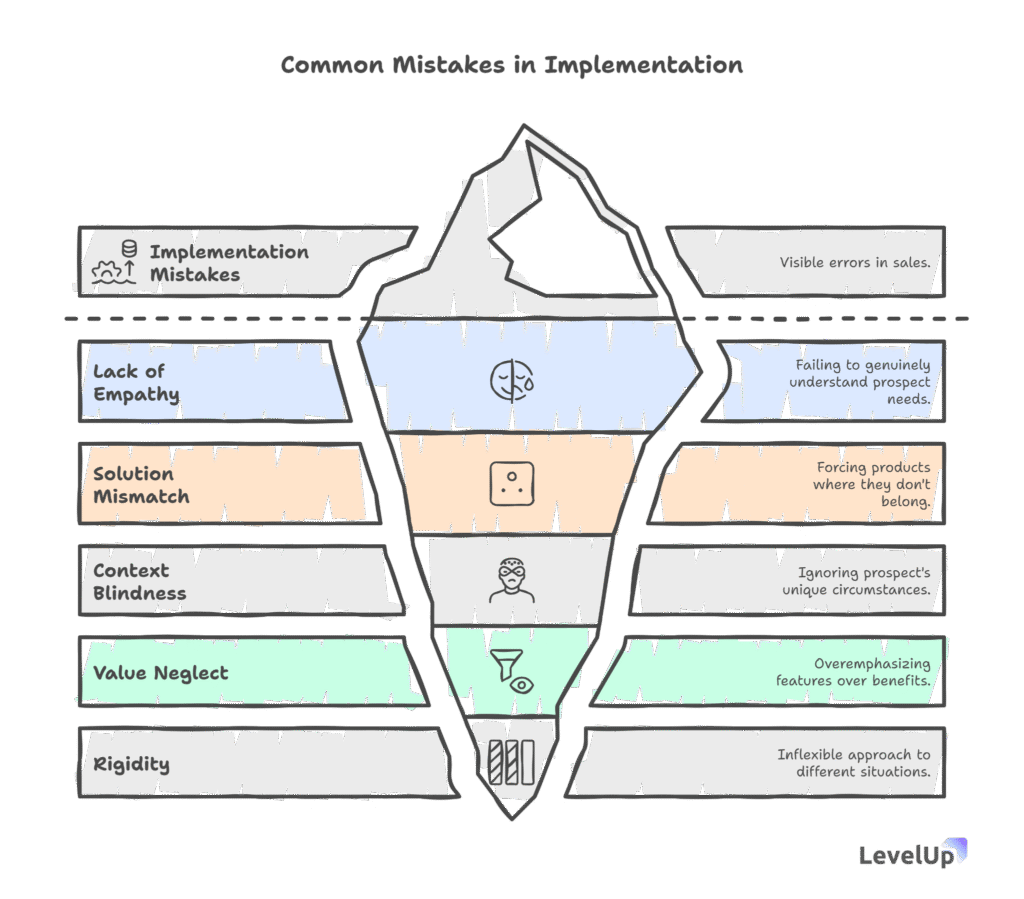
Product Selling Mistakes:
Feature Dumping: Overwhelming prospects with every capability instead of focusing on relevant benefits.
One-Size-Fits-All Pitches: Using identical presentations for different types of buyers.
Ignoring Context: Not understanding the prospect’s industry, company size, or specific situation.
Competitive Obsession: Spending more time talking about competitors than your own value.
Premature Pricing: Leading with cost before establishing value.
The biggest mistake I see? Thinking you have to choose one approach exclusively. The best salespeople I know blend both methodologies based on the situation.
Building Your Solution Selling Process
If you’re convinced that solution selling is right for your business, here’s how to implement it without losing your mind (or your current customers).
Step 1: Develop Your Discovery Framework
Create a structured approach to understanding customer problems. I use what I call the “Problem Stack”:
Surface Problems: What the customer initially says is wrong.
Root Causes: The underlying issues causing the surface problems.
Impact Assessment: How these problems affect the business.
Success Criteria: What “solved” looks like to the customer.
Step 2: Train Your Team on Consultative Skills
This isn’t just about asking better questions. Your team needs to:
- Listen actively (not just wait for their turn to talk)
- Ask follow-up questions that dig deeper
- Summarize and confirm understanding
- Connect problems to business impact
- Present solutions in the customer’s language
Step 3: Create Problem-Focused Content
Your marketing materials should address problems, not just features. Instead of “Advanced Analytics Dashboard,” try “Stop Guessing What Your Customers Actually Want.”
Step 4: Implement Qualification Criteria
Not every prospect is worth the solution selling investment. Develop criteria for when to use this approach versus a more straightforward product presentation.
Step 5: Measure the Right Metrics
Track more than just close rates. Look at:
- Average deal size
- Sales cycle length
- Customer lifetime value
- Referral rates
- Implementation success rates
Technology’s Role in Modern Selling
Here’s something that’s changed dramatically in recent years: technology is making both approaches more effective, but in different ways.
Solution Selling Tech Stack:
CRM Systems: Track detailed discovery notes and problem identification across the sales team.
Conversation Intelligence: Tools that analyze sales calls to identify successful discovery patterns.
Customer Research Platforms: Gather insights about prospects before initial conversations.
Demo Management Tools: Create customized demonstrations based on discovered problems.
For example, at Levelup Demo, we’ve built our entire platform around the solution selling methodology. Instead of just scheduling demos, our tool helps sales teams capture specific pain points during the request process, qualify leads based on problem fit, and track outcomes based on how well solutions address identified problems.
Product Selling Technology:
Configuration Tools: Help prospects build and price solutions independently.
Comparison Engines: Allow feature-by-feature competitive analysis.
Self-Service Demos: Let prospects evaluate products without sales involvement.
Automated Nurturing: Deliver relevant product information based on browsing behavior.
The key is choosing technology that supports your chosen methodology rather than working against it.
Measuring Success: KPIs for Each Approach
You can’t improve what you don’t measure, and different selling approaches require different metrics.
Solution Selling KPIs:
Discovery Quality Score: Rate how well your team identifies and documents customer problems.
Solution Fit Rating: Measure how closely your proposed solution matches identified needs.
Customer Satisfaction with Sales Process: Survey prospects on their experience, regardless of whether they buy.
Time to Value: How quickly customers see results after implementation.
Expansion Revenue: Existing customers buying additional solutions.
Product Selling KPIs:
Conversion Rate by Feature Set: Which product capabilities drive the most conversions.
Price Sensitivity Analysis: How pricing changes affect close rates.
Competitive Win Rate: Success against specific competitors.
Sales Velocity: Time from first contact to closed deal.
Feature Adoption: Which promoted features customers actually use.
I’ve found that solution selling typically shows better long-term metrics while product selling often wins on short-term efficiency measures.
Industry-Specific Considerations
Different industries respond differently to these approaches, and understanding your market is crucial.
Technology/SaaS:
Solution selling dominates here because software purchases are often strategic decisions with multiple stakeholders. However, freemium and product-led growth models are bringing back elements of product selling.
Professional Services:
Almost exclusively solution selling territory. Clients are buying outcomes, not deliverables.
Manufacturing:
Often a hybrid approach. Technical specifications matter (product selling), but operational impact is crucial (solution selling).
Healthcare:
Heavily regulated industry where compliance and patient outcomes drive decisions. Solution selling with extensive proof points.
Financial Services:
Risk-averse buyers who need both detailed product information and clear problem-solution fit.
The key is understanding your buyer’s decision-making process and adapting accordingly.
Building a Hybrid Approach
Here’s what I’ve learned after years of implementation: the best sales organizations don’t choose one approach exclusively. They develop the judgment to use the right method for each situation.
When to Lead with Solution Selling:
- New market segments
- Complex, high-value deals
- Multiple decision makers
- Unclear or evolving requirements
- Competitive situations where differentiation is key
When to Use Product Selling:
- Repeat customers with known needs
- Simple, well-understood products
- Price-sensitive buyers
- Technical evaluations
- Procurement-driven processes
Creating Flexibility in Your Process:
Qualification Questions: Early in the process, determine which approach fits best.
Team Training: Ensure your sales team is comfortable with both methodologies.
Content Library: Develop materials that support both approaches.
Technology Configuration: Set up your systems to handle different sales processes.
Performance Management: Recognize that different approaches may have different success metrics.
Common Objections and How to Handle Them
Let me address the pushback I typically hear when discussing these approaches:
“Solution selling takes too long”
Actually, it often shortens sales cycles by reducing back-and-forth and objections. When customers feel understood, they move faster.
“Our product sells itself”
Maybe, but your competitors’ products probably “sell themselves” too. Solution selling creates differentiation beyond features.
“Our buyers just want pricing”
Some do, but many use price requests as a way to control the conversation. Good discovery often reveals that price isn’t the real concern.
“We don’t have time for extensive discovery”
You don’t need hour-long interrogations. Even five minutes of good questions can transform a conversation.
“Product selling is more scalable”
True for simple products, but solution selling often leads to larger deals and better retention, improving overall efficiency.
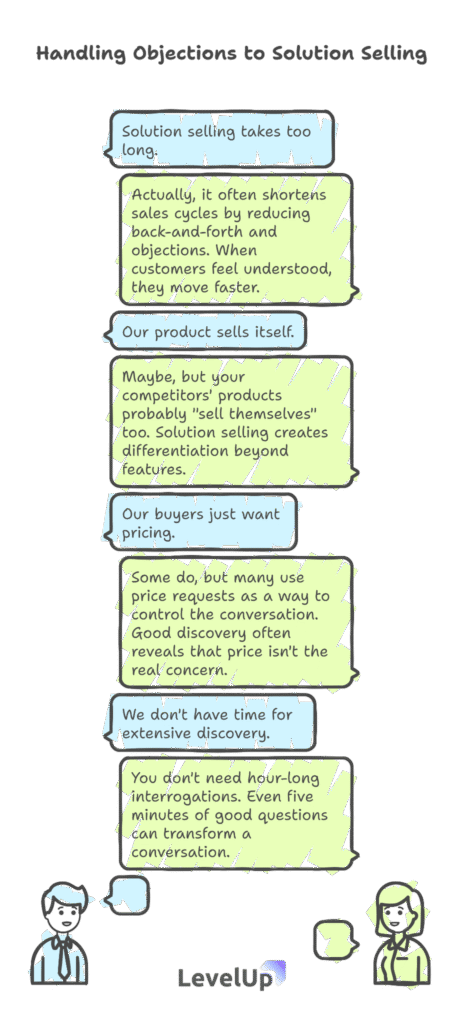
The Future of Selling
Based on current trends, I see the line between solution and product selling continuing to blur, but in interesting ways.
Buyer Self-Education: Prospects research extensively before engaging sales. This means they often come with specific problems already identified.
AI-Assisted Discovery: Tools that help salespeople ask better questions and identify patterns in customer problems.
Personalization at Scale: Technology enabling customized approaches without manual effort.
Value-Based Selling: Evolution beyond solution selling to focus on measurable business outcomes.
Collaborative Selling: Buyers and sellers working together to design solutions.
The companies that thrive will be those that can adapt their approach based on buyer preferences and market conditions.
FAQ Section
What is the main difference between solution selling and product selling?
Solution selling focuses on identifying and solving customer problems through a consultative approach, while product selling emphasizes product features and benefits. The key difference is starting point: solution selling begins with customer needs, product selling begins with product capabilities.
Which approach works better for SaaS companies?
Most SaaS companies benefit from solution selling, especially for complex or high-value products. However, simple tools with clear use cases can succeed with product selling. The key is matching your approach to your product complexity and buyer sophistication.
How do I know if my team should use solution selling?
Consider solution selling if you have: complex products, long sales cycles, multiple stakeholders, competitive markets, or high-value transactions. If your product is simple, low-cost, or commodity-like, product selling might be more efficient.
Can I use both approaches with the same customer?
Absolutely. You might start with solution selling to understand needs, then shift to product selling when demonstrating specific features. The best salespeople adapt their approach based on the conversation flow and buyer preferences.
How long does it take to implement solution selling?
Expect 3-6 months for full implementation. This includes team training, process development, content creation, and system setup. However, you can start seeing improvements within weeks by simply asking better discovery questions.
What are the biggest challenges in solution selling?
Common challenges include: longer sales cycles initially, need for more skilled salespeople, difficulty scaling, and resistance from prospects who want quick answers. Success requires commitment and proper training.
Does solution selling work in competitive situations?
Yes, often better than product selling. When multiple vendors have similar features, the one who best understands and addresses customer problems typically wins. Solution selling creates differentiation beyond product capabilities.
How do I measure solution selling success?
Track metrics like: customer lifetime value, deal size, sales cycle length, customer satisfaction scores, referral rates, and implementation success. Don’t just focus on close rates—solution selling often improves overall relationship quality.
What if prospects just want pricing information?
Use pricing requests as discovery opportunities. Ask: “To give you accurate pricing, can you help me understand your specific situation?” Often, price requests mask deeper concerns about value or fit.
Can small sales teams effectively use solution selling?
Yes, but it requires focus. Small teams should develop strong discovery skills and create efficient processes. Tools like Levelup Demo can help streamline the solution selling process without requiring large sales operations teams.
Action Steps and Implementation Guide
Ready to optimize your sales approach? Here’s your roadmap:
For Beginners (New to Sales Strategy):
- Assess Your Current Approach: Record a few sales calls and identify whether you’re leading with problems or products.
- Develop Basic Discovery Questions: Create 5-10 questions that help you understand customer challenges before presenting solutions.
- Practice Active Listening: Focus on understanding, not just responding. Summarize what you hear before moving forward.
- Start Small: Try solution selling with your next 5 prospects and compare results to your usual approach.
For Intermediate Teams (Some Sales Experience):
- Create Buyer Personas: Develop detailed profiles including common problems, decision criteria, and success metrics.
- Build Problem-Solution Maps: Document how your product addresses specific customer challenges.
- Implement Call Recording: Use tools to analyze successful vs. unsuccessful discovery conversations.
- Develop Qualification Criteria: Determine when to use solution selling vs. product selling based on deal characteristics.
For Advanced Organizations (Established Sales Teams):
- Create Hybrid Methodologies: Develop frameworks that blend both approaches based on buyer signals.
- Implement Advanced Analytics: Track problem identification accuracy, solution fit scores, and outcome correlation.
- Build Customer Success Integration: Connect sales discovery to post-sale success metrics.
- Develop Coaching Programs: Train managers to recognize and improve discovery skills across the team.
Universal Next Steps:
This Week: Choose one discovery question to add to every sales conversation.
This Month: Analyze your last 10 deals to identify patterns between problem identification and close rates.
Next Quarter: Implement systematic tracking of customer problems and solution outcomes.
Long-term: Build a culture where understanding customer problems is valued as much as closing deals.
Key Takeaways
After diving deep into solution selling vs product selling, here are the critical points to remember:
Context Matters Most: Neither approach is universally superior. Your market, product complexity, and buyer preferences should drive your methodology choice.
Hybrid Approaches Win: The most successful sales teams can adapt their approach based on the situation rather than rigidly following one methodology.
Customer Problems Are Gold: Whether you use solution or product selling, understanding customer challenges always improves outcomes.
Implementation Takes Time: Don’t expect overnight transformation. Building consultative skills and processes requires consistent effort and practice.
Technology Amplifies, Doesn’t Replace: Tools can make both approaches more effective, but they can’t substitute for genuine customer understanding and relationship building.
Remember that conversation I overheard in the coffee shop? Both founders were partially right. Features matter, but only when they solve real problems. The magic happens when you can connect your product’s capabilities to your customer’s challenges in a way that feels natural and valuable.
Whether you choose solution selling, product selling, or a hybrid approach, the goal remains the same: helping customers make decisions that truly benefit their business. When you nail that, everything else—close rates, deal sizes, customer satisfaction—tends to fall into place.
The sales landscape will keep evolving, but one thing won’t change: customers will always prefer working with people who understand their world and genuinely want to help them succeed.
If you’re looking for tools to support your solution selling process, consider how Levelup Demo can help you capture, qualify, and track the customer problems that drive successful sales outcomes. After all, the best sales methodology is only as good as your ability to execute it consistently.
